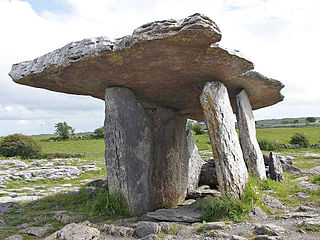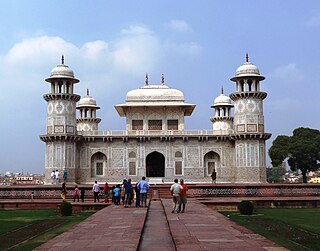
A dolmen is a type of single-chamber megalithic tomb, usually consisting of two or more vertical megaliths supporting a large flat horizontal capstone or "table". Most date from the early Neolithic and were sometimes covered with earth or smaller stones to form a tumulus. Small pad-stones may be wedged between the cap and supporting stones to achieve a level appearance. In many instances, the covering has weathered away, leaving only the stone "skeleton" of the mound intact.
English usually refers to:
Tomb Raider, also known as Lara Croft: Tomb Raider between 2001 and 2007, is a media franchise that originated with an action-adventure video game series created by British gaming company Core Design. Formerly owned by Eidos Interactive, then by Square Enix after their acquisition of Eidos in 2009, the franchise focuses on fictional British archaeologist Lara Croft, who travels around the world searching for lost artefacts and infiltrating dangerous tombs and ruins. Gameplay generally focuses on exploration of environments, solving puzzles, navigating hostile environments filled with traps, and fighting numerous enemies. Additional media has been developed for the franchise in the form of film adaptations, comics and novels.
A patronymic, or patronym, is a component of a personal name based on the given name of one's father, grandfather (avonymic), or an earlier male ancestor. A component of a name based on the name of one's mother or a female ancestor is a matronymic. A name based on the name of one's child is a teknonymic or paedonymic. Each is a means of conveying lineage.

A tomb is a repository for the remains of the dead. It is generally any structurally enclosed interment space or burial chamber, of varying sizes. Placing a corpse into a tomb can be called immurement, and is a method of final disposition, as an alternative to for example cremation or burial.
A surname, family name, or last name is the portion of a personal name that indicates a person's family. Depending on the culture, all members of a family unit may have identical surnames or there may be variations based on the cultural rules.

William Holman Hunt was an English painter and one of the founders of the Pre-Raphaelite Brotherhood. His paintings were notable for their great attention to detail, vivid colour, and elaborate symbolism. These features were influenced by the writings of John Ruskin and Thomas Carlyle, according to whom the world itself should be read as a system of visual signs. For Hunt it was the duty of the artist to reveal the correspondence between sign and fact. Of all the members of the Pre-Raphaelite Brotherhood, Hunt remained most true to their ideals throughout his career. He was always keen to maximise the popular appeal and public visibility of his works.

Eleanor of Lancaster, Countess of Arundel was the fifth daughter of Henry, 3rd Earl of Lancaster and Maud Chaworth.

A cooper is a person trained to make wooden casks, barrels, vats, buckets, tubs, troughs and other similar containers from timber staves that were usually heated or steamed to make them pliable.

Humayun's tomb is the tomb of the Mughal Emperor Humayun in Delhi, India. The tomb was commissioned by Humayun's first wife and chief consort, Empress Bega Begum, in 1569-70, and designed by Mirak Mirza Ghiyas and his son, Sayyid Muhammad, Persian architects chosen by her. It was the first garden-tomb on the Indian subcontinent, and is located in Nizamuddin East, Delhi, India, close to the Dina-panah Citadel, also known as Purana Qila, that Humayun found in 1533. It was also the first structure to use red sandstone at such a scale. The tomb was declared a UNESCO World Heritage Site in 1993, and since then has undergone extensive restoration work, which is complete. Besides the main tomb enclosure of Humayun, several smaller monuments dot the pathway leading up to it, from the main entrance in the West, including one that even pre-dates the main tomb itself, by twenty years; it is the tomb complex of Isa Khan Niyazi, an Afghan noble in Sher Shah Suri's court of the Suri dynasty, who fought against the Mughals, constructed in 1547 CE.
The birth name is the name of the person given upon their birth. The term may be applied to the surname, the given name or to the entire name. Where births are required to be officially registered, the entire name entered onto a births register or birth certificate may by that fact alone become the person's legal name. The assumption in the Western world is often that the name from birth will persist to adulthood in the normal course of affairs—either throughout life, or until marriage. Some possible changes concern middle names, diminutive forms, changes relating to parental status, and changes related to gender transition. Matters are very different in some cultures in which a birth name is for childhood only, rather than for life.
A formal Irish-language personal name consists of a given name and a surname. Surnames in Irish are generally patronymic in etymology, although they are no longer literal patronyms, as most Icelandic names are. The form of a surname varies according to whether its bearer is male or female and in the case of a married woman, whether she chooses to adopt her husband's surname.
Khawaja is an honorific title used across the Middle East, South Asia, Southeast Asia and Central Asia, particularly towards Sufi teachers. The word comes from the Iranian word khwāja and translates as "master", "lord". The spellings hodja or hoca (Turkish), খাজা (Khaaja) (Bengali), hodža (Bosnian), hoxha (Albanian), хоџа (Serbian), χότζας (chótzas) (Greek), hogea (Romanian), koja (Javanese). The name is also used in Egypt and Sudan to indicate a person with a foreign nationality or foreign heritage.

A church monument is an architectural or sculptural memorial to a deceased person or persons, located within a Christian church. It can take various forms ranging from a simple commemorative plaque or mural tablet affixed to a wall, to a large and elaborate structure, on the ground or as a mural monument, which may include an effigy of the deceased person and other figures of familial, heraldic or symbolic nature. It is usually placed immediately above or close to the actual burial vault or grave, although very occasionally the tomb is constructed within it. Sometimes the monument is a cenotaph, commemorating a person buried at another location.

Al-Nabi Sheeth is a village in the Beqaa Valley of Lebanon. "Al-Nabi Sheeth" is Arabic for "Seth the prophet". The village was called by that name because it is considered to contain the burial site of Seth son of Adam. A mosque was built on the burial site and it contains the grave of Seth inside the mosque.. The village is also the home town of Abbas al-Musawi former Hezbollah leader and influential shia cleric. The village of Al-Nabi Sheeth is predominantly inhabited by people with the surnames Helbawi, Al-Moussawi, Hazimeh, & Chokr families being well known.
Smythe, an uncommon spelling of the surname Smith, may refer to:

Ayen is a commune in the Corrèze department in the Nouvelle-Aquitaine region of central France.
Cornish surnames are surnames used by Cornish people and often derived from the Cornish language such as Jago, Trelawney or Enys. Others have strong roots in the region and many in the UK with names such as Eddy, Stark or Rowe are likely to have Cornish origins. Such surnames for the common people emerged in the Middle Ages, although the nobility probably had surnames much earlier on. Not until the later Middle Ages did it become necessary for a common man to have a surname. Most surnames were fully established throughout Cornwall by the end of the 15th century. Today Cornish surnames can be found throughout the world as part of the Cornish diaspora.

Syed Ibrahim Mallick, Sayyid Ibrahim Mallick Baya, Mallick, Malick, or Malik are the possible spellings used for the same name by Mallicks from Bihar, India. Syed Ibrahim Mallick came to India during the time of Sultan Mohammad Tughlaq in 740 Hijri.. Syed Ibrahim's ancestors were native of Baghdad who migrated to Afghanistan and settled in the district of Gardez Budt Nagar, which was located near Ghazni. He died in 1353 under the reign of Firuz Shah Tughlaq.
Yun (윤) is the ninth most common family name in Korea. The name is sometimes also transliterated as Yoon, Yune, Yiun, or Youn.









